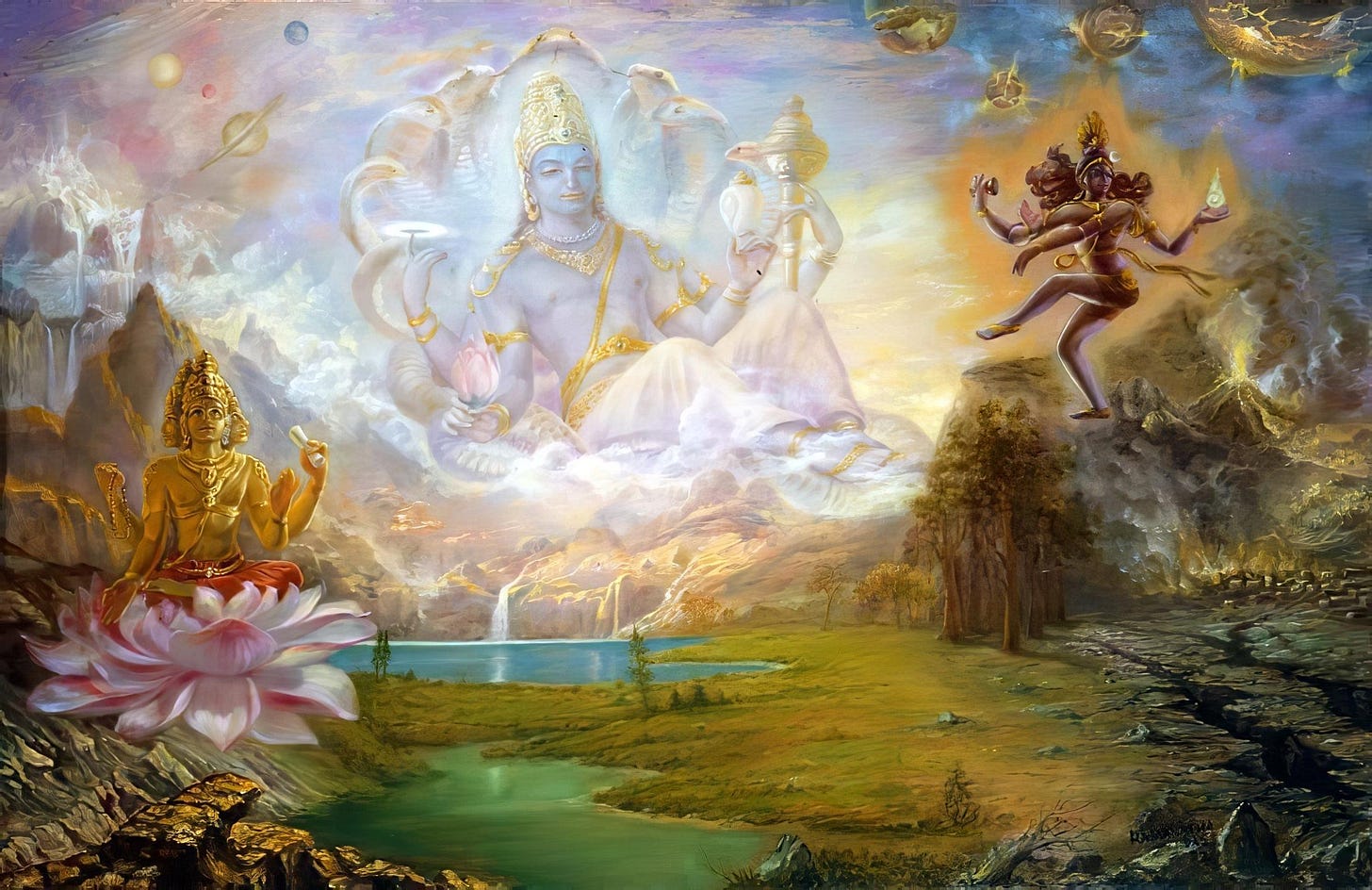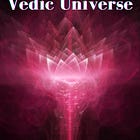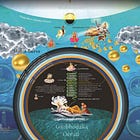How do the Vedas explain the process of populating the Universe?
When Uttānapāda, the son of Manu, became the king, even before begetting his children, there were already people living on the planet. So, where did they come from?
In the Srimad Bhagavatam, it is described that at the beginning of the current cycle of creation, Brahma created several male mental children, and the first couple appeared when he created Svāyambhuva Manu and his wife.
Svāyambhuva Manu had five children: three daughters and two sons. The first daughter, Ākūti, was given in marriage to the sage Ruci, the middle daughter, Devahūti, to the sage Kardama, and the youngest, Prasūti, to Prajapati Dakṣa. From the two sons, the first, Priyavrata, became a renunciant, while the second, Uttanapada, became the father of Dhruva Maharaja and his half-brother Uttama.
By studying this description, one could question where the rest of humanity came from, as well as all the animals, plants, and other beings who populated the different planets. Early in the current day of Brahma, when Kardama Muni was meditating (before accepting Devahūti, the daughter of Manu, as his wife), the earth was not a desert. In the Srimad Bhagavatam (3.21.40-44), it is described that his hermitage was a very beautiful place, surrounded by all kinds of plants and animals:
"The shore of the lake was surrounded by clusters of pious trees and creepers, rich in fruits and flowers of all seasons, that afforded shelter to pious animals and birds, which uttered various cries. It was adorned by the beauty of groves of forest trees. The area resounded with the notes of overjoyed birds. Intoxicated bees wandered there, intoxicated peacocks proudly danced, and merry cuckoos called one another. Lake Bindu-sarovara was adorned by flowering trees such as kadamba, campaka, aśoka, karañja, bakula, āsana, kunda, mandāra, kuṭaja and young mango trees. The air was filled with the pleasing notes of kāraṇḍava ducks, plavas, swans, ospreys, waterfowl, cranes, cakravākas and cakoras. Its shores abounded with deer, boars, porcupines, gavayas, elephants, baboons, lions, monkeys, mongooses and musk deer."
Similarly, when Uttānapāda, the son of Manu, became the king, even before begetting his children, there were already people living on the planet. So, where did they come from?
The point is that the Srimad Bhagavatam (as well as the other Puranas) don't speak much about the direct creation of human beings, just as they don't speak much about the creation of lower animals and other species. Although it may sound interesting to us, this is not considered a very important topic by the sages who transmitted the scriptures. In the Tattva Sandarbha, Srila Jiva Goswami mentions that all 18 Puranas were compiled by Srila Vyāsadeva from a much larger book (of one billion verses!) that is studied in the higher planets by the demigods. Understanding that it would be impossible for us to study such a large book, Vyāsadeva compiled the 18 Puranas, taking only the most relevant parts to different classes of people. In this way, from the original one billion verses, we have access to 18,000 verses in the Srimad Bhagavatam, and a total of 400,000 if we add the verses from all other Puranas.
It's understood that human beings, animals, and plants have existed on different planets since the beginning of the universe, but the scriptures we have access to on our planet don't speak so much about them, focusing instead on describing the activities of great personalities, who transmitted important spiritual knowledge. However, just because something is not comprehensibly described in the scriptures doesn't necessarily mean it didn't happen.
The creation of different species of life happens repeatedly thanks to the seven great sages, as well as other Prajāpatis, like Daksa, who, in cooperation with their wives, repeatedly populate the universe. In the sixth canto of Srimad Bhagavatam, chapter 6, there is a description of how the sixty daughters of Daksa gave birth to most of the population of the universe, from plants to demigods. Timi gave birth to different aquatics, while Saramā to ferocious animals like tigers and lions. Ilā to different creepers and trees, Aditi gave birth to the demigods, while Diti to the demons. Mātṛkā gave birth to the human species and so on. This description from the 6th canto narrates events from the reign of Cākṣuṣa Manu (the 6th of the sequence) when Daksa took his second birth, but the universe is populated in a similar way by different Prajāpatis at every Manvantara, starting from the reign of Svāyambhuva Manu. Brahma himself creates the different species at the beginning of his day as a blueprint, or as a seed, and the Prajāpatis take charge of bringing forth generations of living entities and increasing their population. During the day of Brahma, different species are repeatedly extinct and later repopulated by the Prajāpatis.
A seed already contains a plant, but to grow and develop, this plant has to be planted in the right conditions. With the exception of his mental sons, Brahma doesn't directly create living entities. What he does is to create the seeds, so to speak, of the different species of life and give them to the Prajāpatis, who bring forth generations of living beings as necessary. Even if certain species become extinct at a certain point, the seed still exists, and thus the Prajāpatis can repopulate it at any point. Of course, when we speak about "seed", this is just an imperfect analogy to try to explain a complicated concept. In reality, we are not speaking about a physical object, but some kind of subtle manifestation.
Another example that can be given is a project or blueprint. Creating something is not necessarily the same as producing it. A person may project a car and then give the project to a company that may produce it, or many different companies may produce the car at the same time or at different points in time. As soon as the project is made, the car already exists, and it continues to exist as long as the project is circulating around, and different companies may produce it at different times. Similarly, Brahma creates the different forms of life, and the Prajāpatis "produce" them as necessary.
For example, we learn that there were human beings living on Earth since the beginning of the reign of Svāyambhuva Manu, leading to the reign of Uttānapāda, the progress during the reign of Pṛthu Maharaja, and so on. However, as narrated in the 4th canto, when the Pracetas came out of the ocean at the end of their austerities, the planet was covered by trees. Apparently, there were no humans living there at this time.
By the arrangement of the demigod Soma, they got married to Marisa, the daughter of the apsara Pramloca, and begot Daksa (in his second birth). However, Daksa didn't have children immediately (he practiced austerities until the sixth manvantara and only then had his 60 daughters who married great sages and repopulated the universe after the destruction at the end of the 5th manvantara, as described in the 6th canto.
In the meantime, while Daksa was meditating, Svāyambhuva Manu had to ask Priyavrata, the older brother of Uttānapāda, to abandon his practice of austerities and accept the responsibility of managing Bhu-Mandala and bringing forth new generations of human beings, which he did in cooperation with his wife.
As we can see, the work of the Prajāpatis is continuous, following the different cycles of devastation our universe passes through. There is one devastation at the end of the reign of each Manu, which affects not only our planet but also the populations of demigods and demons. There is a small devastation at the end of each Kali-yuga (after which our planet is repopulated), and so on. In this way, the Prajāpatis as well as the Manus and other higher beings are constantly engaged in creating new populations and maintaining the proper conditions for the existence of life all over the universe.
In his purport on SB 4.28.10, Srila Prabhupada mentions:
"From the Vedic history of creation, we can understand that the first living creature was Lord Brahmā, who created the seven great sages and other Prajāpatis to increase the universal population. Thus every living entity, according to karma, his past desires and activities, gets a particular type of body, from that of Brahmā to that of a microbe or germ in stool."
Here he mentions the seven great sages (sapta-rishi), who together with Daksa and the Manus are considered the main Prajāpatis. From the Srimad Bhagavatam, we receive details about the history of Daksa, but the seven sages are mentioned much more sparingly.
The original seven great sages were Marīci, Atri, Aṅgirā, Pulastya, Pulaha, Kratu, and Bhṛgu, seven of the direct sons of Brahma, who resided in the seven stars below Dhruvaloka (which are part of the planetary system of Maharloka). In his Sat-Sandarbha, Srila Jiva Goswami mentions that each team of seven sages executes their functions as Prajāpatis for a whole manvantara. With the end of the Manvantara, the seven sages are promoted to Janaloka, where they live until the final devastation of the universe.
Our universe is divided into 14 levels of planetary systems, going from Patalaloka to Brahmaloka. The seven lower planetary systems are inhabited by demons, the 8th, Bhu-Mandala, is inhabited by human beings, the 9th by subtle beings (the Yakshas and Rakshasas), and the 10th is Svargaloka, inhabited by demigods. All these 10 planetary systems are affected by the devastation at the end of each Manvantara and are completely destroyed at the end of each day of Brahma. The other planetary systems, Maharloka, Janaloka, Tapoloka, and Satyaloka, are created once at each of the two halves of the day of Brahma and exist until the complete devastation of the universe.
What happens when the seven sages are promoted to Janaloka? A new team takes charge, just like in the case of the main demigods. It's mentioned (SB 8.13.15-16) that some of the great personalities mentioned in the Mahabharata, such as Paraśurāma, Aśvatthāmā, Kṛpācārya, and Vyāsadeva, are currently engaged in meditation in Badarīkāśrama, preparing themselves to assume posts amongst the seven sages in the next Manvantara, just like Bali Maharaja is waiting to assume the post of Indra. One could question how human beings such as Aśvatthāmā and Kṛpācārya can become Prajāpatis without changing their bodies, but the main question is not the body, but their consciousness. Once the consciousness is purified, the body can also be purified.
The first group of seven sages are direct sons of Brahma (just like Daksa, Narada, the four Kumaras, and Svāyambhuva Manu), but the Prajāpatis in the next Manvantaras are descendants of them. In his first birth, Daksa was the son of Brahma, but in his second birth, he was born out of the Pracetas, who were in turn descendants of Uttānapāda, the son of Svāyambhuva Manu.
In this way, different personalities take the roles of Prajāpatis in the different manvantaras, repopulating the lower planetary systems when needed. At the end of the current day of Brahma, the ones who qualify will be promoted to the highest planetary systems (Janaloka, Tapoloka, and Satyaloka) where they will live until the final devastation of the universe. After such a long life, the ones who qualify will be able to finally attain liberation and reach the spiritual planets.
One could also question how the Prajāpatis, who are evolved human beings, living in the higher planetary systems, can give birth to lower animals and plants, which have completely different bodily structures. Saramā, for example, gave birth to tigers and lions, although neither she nor her husband are felines. How does this work? The point the Vedas explain is that more evolved beings have the capacity to generate less evolved beings (like a Prajapati generating a tiger), but the opposite doesn't happen. Life in the universe starts thus from the most evolved being, Brahma, who in turn generates slightly less evolved beings (the Prajāpatis), who in turn generate all the other less evolved species of life. This is something that can be observed even on our planet. Human beings can manipulate less evolved organisms using artificial insemination and genetic manipulation. A human being can clone a sheep or create a GMO soy seed, for example, but will never be capable of producing a demigod.
We can see that this is essentially the opposite of what is believed in the modern evolution theory, which says that lower forms of life gradually produce more evolved forms, starting with inanimate matter somehow producing very simple unicellular organisms, which in turn gradually evolve into more complex species, culminating with human beings. One may have a different opinion, but I personally believe that the description of the Vedas makes more sense.
Another possible objection is to my use of the word "evolved". When I say that human beings are more "evolved" than animals like tigers and lions, it appears that this supports the theory of evolution from Darwin, but that's not actually the case. Prabhupada makes the point that the Vedas also offer a theory of evolution, it's just that it's different from what Darwin wrote about. The Vedic idea is that the soul gradually evolves from unicellular organisms to plants, insects, birds, lower animals, and so on, eventually reaching the human species. In this way, when we speak about humans being more "evolved" than lower animals, we are referring to this process of spiritual evolution, where the soul transmigrates through different types of bodies, going from less evolved living beings, all the way up to Brahma, the most evolved.
Read also:
If you read this article to the end, give it a like. This makes Substack recommend it to more people. If you can’t contribute in other ways, you can contribute by just doing that.
If you have questions, use the comments; I will answer as possible. They may even become the topic for another article. Your thoughts and opinions are also very welcome. ⤵️





